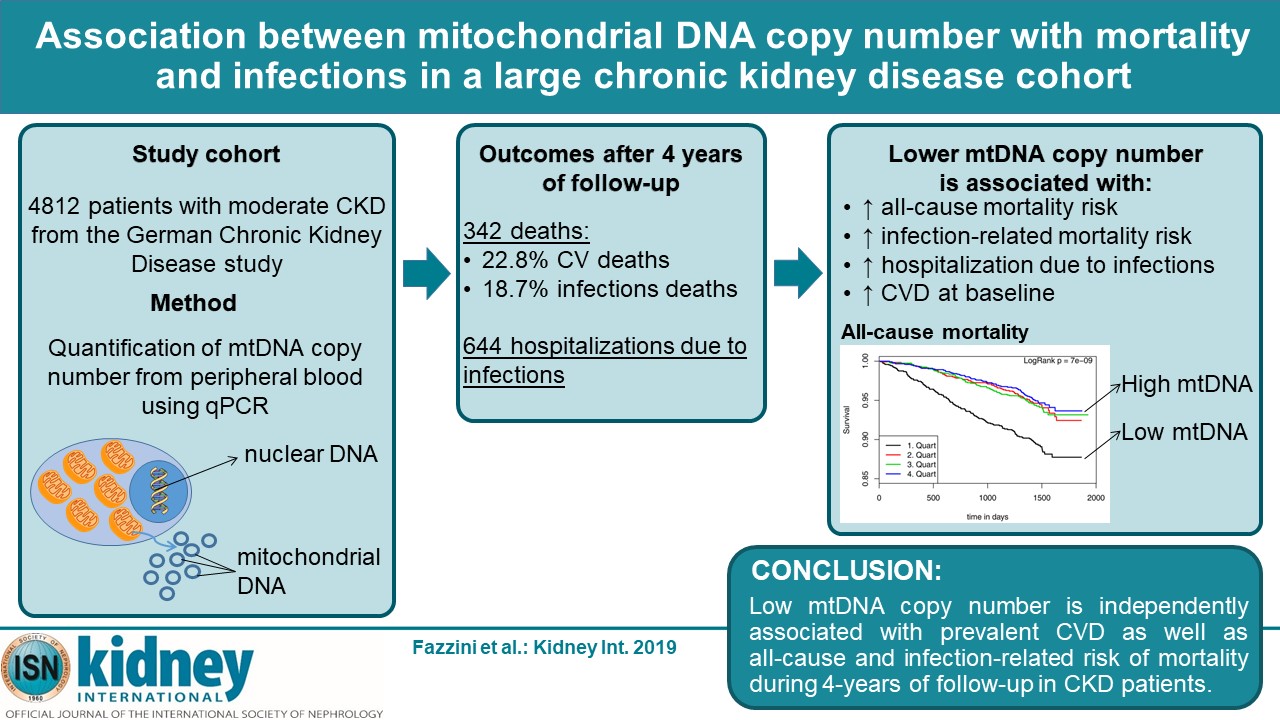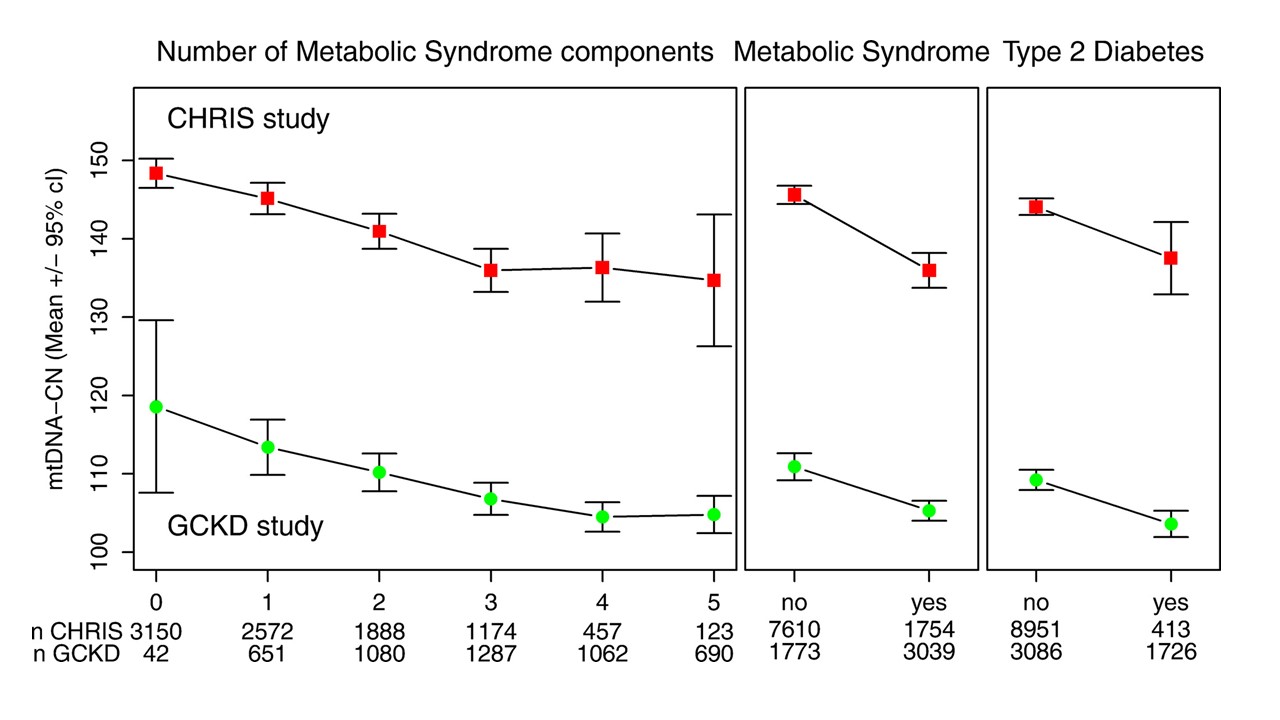Mitochondrial DNA copy number
Members
Principal Investigator (PI)
Team
Adriana Koller , Claudia Lamina , Barbara Kollerits , Sebastian Schönherr , Hansi Weissensteiner , Lukas Forer , Stefan Coassin
About
Mitochondria play an essential role in cellular energy production and multiple hemostatic pathways. Therefore mitochondrial dysfunction is a hallmark of many diseases. In contrast to nuclear DNA that exists in two copies, up to several thousand copies of mitochondrial DNA exist per cell. The number of copies of mitochondrial DNA is considered to be a surrogate for mitochondrial function/dysfunction especially in energy-dependent tissues.
Quantification of mtDNA copy numbers
Before we started to measure mtDNA copy numbers we established a method for quantification that uses a quantitative PCR assay that allows for simultaneous targeting of a single copy nuclear gene (beta-2-microglobulin) and the t-RNALeu gene on the mtDNA. We include a plasmid containing both targets in order to normalize against differences in emission intensities of the fluorescent dyes Yakima Yellow and FAM. Applying the plasmid calibrator on an internal control reduced the intra-assay variability from 21% (uncorrected) to 7% (plasmid-corrected). The measurement by quantitative PCR especially when a plasmid normalization is used is currently considered as the gold-standard feasible for application in large epidemiological studies. Moreover, we noted that DNA samples isolated with different methods revealed different numbers of mtDNA copies, thus highlighting an important influence of the pre-analytical procedures (Fazzini et al.: Scientific Reports 2018).
mtDNA copy number in patients with chronic kidney disease
We investigated the prognostic role of mtDNA copy number for cause-specific mortality in 4812 patients from the German Chronic Kidney Disease study, a prospective observational study of patients with moderate kidney function impairment (Figure 1). At baseline, the 1235 patients with prevalent cardiovascular disease had a significantly lower mtDNA copy number than patients without cardiovascular disease. After four years of follow-up, we observed a significant inverse association between mtDNA copy number and all-cause mortality, infection-related risk of mortality and hospitalizations due to infections (Fazzini et al.: Kidney Int. 2019).

mtDNA copy number in patients with peripheral arterial disease
In a further study we investigated whether mtDNA copy number is associated with peripheral arterial disease as well as all-cause mortality and cardiovascular events during seven years of follow-up. We showed an association of low mtDNA copy number with all-cause-mortality and prevalent and incident cardiovascular disease in patients with intermittent claudication (Koller et al.: J. Intern. Med. 2020).
mtDNA copy number and metabolic syndrome and type 2 diabetes
We investigate the association of mtDNA copy number with type 2 diabetes and the potential mediating role of metabolic syndrome in two independent studies: 4812 patients from the German Chronic Kidney Disease (GCKD) study and 9364 individuals from the Cooperative Health Research in South Tyrol (CHRIS) study (Fazzini et al.: J. Intern. Med. 2021). In both studies, mtDNA copy number showed a significant correlation with most metabolic syndrome parameters: mtDNA copy number decreased with increasing number of metabolic syndrome components (Figure 2). Furthermore, individuals with low mtDNA copy number had significantly higher odds of metabolic syndrome and type 2 diabetes mellitus. A major part of the total effect of mtDNA copy number on type 2 diabetes was mediated by obesity parameters.

Cooperations
GCKD study, CHRIS Study, CAVASIC Study
Earlier Team Members
Federica Fazzini, Liane Fendt, Patricia Döttelmayer, Barbara Rantner, Marietta Stadler
Publications
Fazzini F, Lamina C, Raftopoulou A, Koller A, Fuchsberger C, Pattaro C, Del Greco FM, Döttelmayer P, Fendt L, Fritz J, Meiselbach H, Schönherr S, Forer L, Weissensteiner H, Pramstaller PP, Eckardt KU, Hicks AA, Kronenberg F, GCKD Investigators: Association of mitochondrial DNA copy number with metabolic syndrome and type 2 diabetes in 14 176 individuals. J. Intern. Med. 290:190-202, 2021. PMID: 33453124 Journal Article
Koller A, Fazzini F, Lamina C, Rantner B, Kollerits B, Stadler M, Klein-Weigel P, Fraedrich G, Kronenberg F: Mitochondrial DNA copy number is associated with all-cause mortality and cardiovascular events in patients with peripheral arterial disease. J. Intern. Med. 287:569-579, 2020. PMID: 32037598 Journal Article
Fazzini F, Lamina C, Fendt L, Schultheiss UT, Kotsis F, Hicks AA, Meiselbach H, Weissensteiner H, Forer L, Krane V, Eckardt KU, Köttgen A, Kronenberg F, GCKD Investigators: Mitochondrial DNA copy number is associated with mortality and infections in a large cohort of patients with chronic kidney disease. Kidney Int. 96:480-488, 2019. PMID: 31248648 Journal Article
Fazzini F, Schöpf B, Blatzer M, Coassin S, Hicks AA, Kronenberg F, Fendt L: Plasmid-normalized quantification of relative mitochondrial DNA copy number. Sci. Rep. 8:15347, 2018. PMID: 30337569 Journal Article
Kronenberg F, Eckardt KU: Mitochondrial DNA and kidney function. Clin. J. Am. Soc. Nephrol. 17:942-944, 2022. PMID: 35777832 Editorial